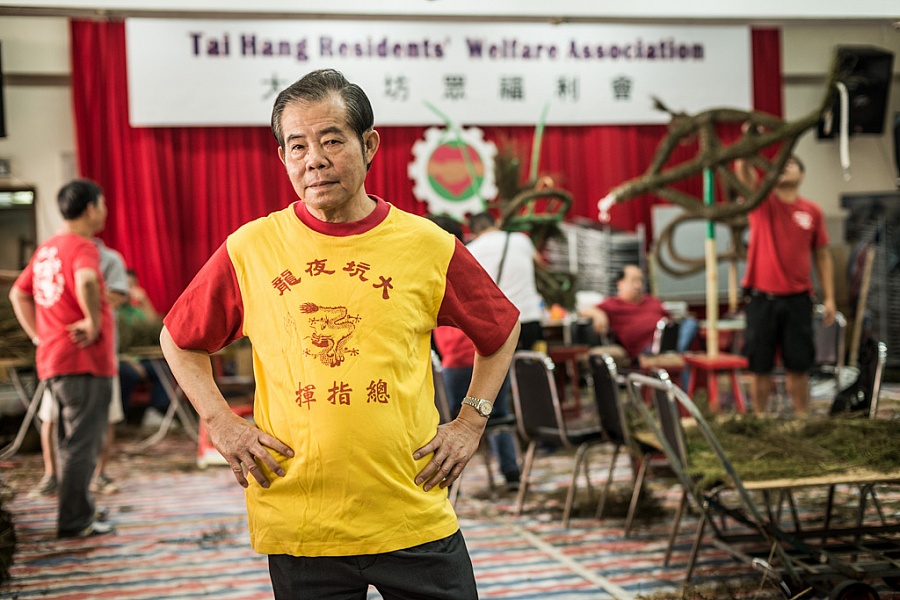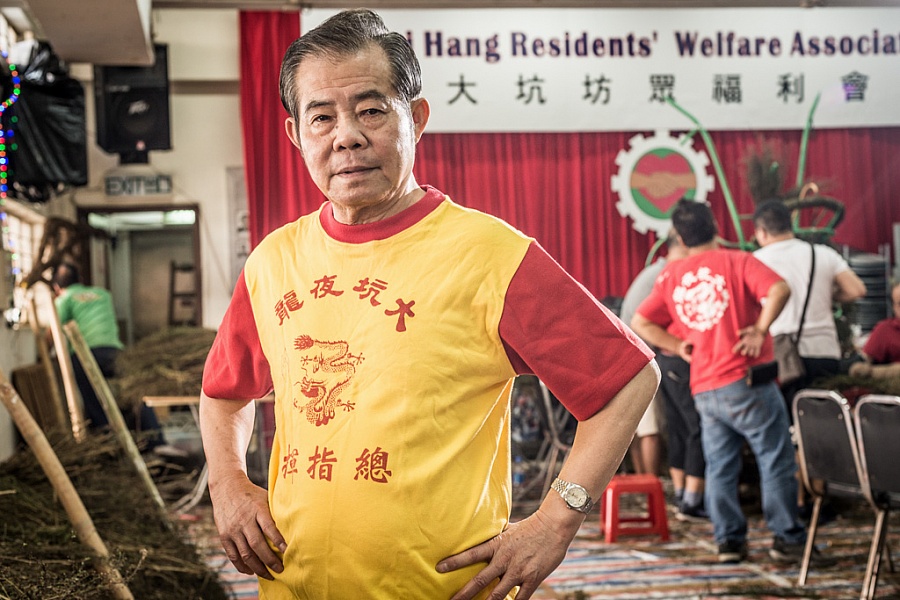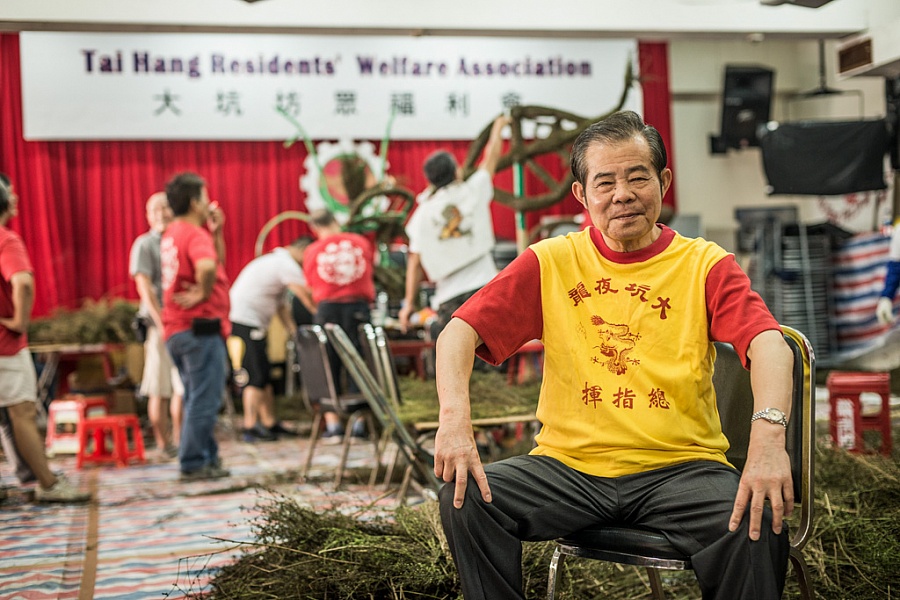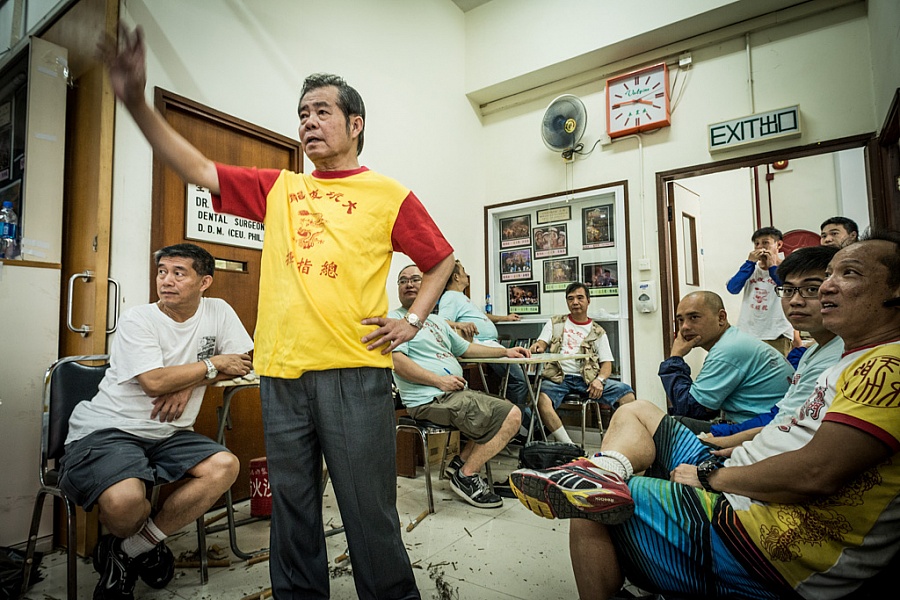Strolling down the streets of Tai Hang in the company of Fai Gor (Cantonese for Brother Fai) is a leisurely yet busy business. When I went to see him on a recent weekday afternoon, our walk and conversation paused many times as locals in the neighbourhood came up to greet the 65-year-old community leader one by one. In one street corner, Fai Gor stopped for more than a few moments to catch up with his friends. At the next, he introduced me to a set of interesting local characters, like a car repair shop owner who gave a long-time employee more than HK$100,000 to start a business because his was about to close down to make way for urban redevelopment. Before I realised, he’d taken me down some hidden (memory) lanes where he’d wax lyrical about stories of old Tai Hang.
Fai Gor remembers everyone, whether they are local residents, shop owners, or workers. In return, they respect him, and many turn to him when disputes arise between individuals. Even the police ask him to help mediate neighbourhood arguments that require official attention.
Chan Tak-fai is a Tai Hang native. The community leader earned the residents’ respect through his service to the community, and the most important contribution he makes is as the Commander-in-Chief of the famous Tai Hang Fire Dragon Dance at Mid-Autumn Festival, a role he’s performed for nearly 40 years. The locals always receive me gladly when they find out I’ve come to them on Fai Gor’s advice. If this intimate community relationship sounds unusual for a neighbourhood that is now best known for its mix of trendy cafes, popular Japanese restaurants and down-to-earth eateries serving authentic Hong Kong fare just behind Causeway Bay, it is because Tai Hang, formerly known as Tai Hang Village, has a long history.
Tai Hang was named after two big water channels that used to run through the village to Victoria Harbour in the old days. Bounded by Tung Lo Wan Road to the north and Tai Hang Road to the south, the village had lied on the seafront for generations until reclamation in the 1950s for the development of Victoria Park pushed it off the shore. A neglected community in the 19th century, there is hardly any written historical record on this multi-clan Hakka village, not even a genealogy record, according to Baptist University history professor Chung Po-yin.
Fai Gor said when he was a kid, the male villagers relied on quarry work to earn a living, while the female villagers did laundry work. It is why Tai Hang’s main street is called Wun Sha (washing clothes) Street. But not even Fai Gor or his long-time friends who have similarly spent their entire lives in Tai Hang were able to tell when their ancestors first settled in the valley.
With the kind assistance of local historian Tim Ko, I managed to find a note in the 1970 Journal of the Royal Asiatic Society Hong Kong Branch which sheds light on the origins of this Hakka village. According to James Hayes, the scholar and former colonial official who authored the note, Tai Hang Village was one of the oldest villages on Hong Kong Island. He believes the earliest settlers probably arrived in the area at around the same time as the British takeover of Hong Kong in 1841. The main families were Wong, Cheung, Lee, Chu and Ip. The villagers farmed, fished and kept some of Hong Kong’s earliest dairy farms.
Fai Gor joined the Fire Dragon team when he was only six, as one of the boys hoisting the cloud lanterns to light up the sky for the dancing dragon. At the age of 12, he became a dragon dancer. “We are Tai Hang boys. Being a dragon dancer was the most natural thing for each and every one of us. It wasn’t about glory. We didn’t even think about terms like glory or vanity. It was face-losing if you’re not participating.”
He has no idea if Tai Hang’s extraordinary football history had something to do with this natural progression into the ranks of the Fire Dragon Dance for the local boys. For unknown reasons, this Hakka village was once home to many of the country’s football stars in the 1930s and 40s. Nine of the 11 footballers representing China at the 1936 Berlin Olympics, including the team’s captain, were Tai Hang villagers. In other words, the Tai Hang football team was effectively the team for the whole nation.
Since he assumed the most important position in the annual Fire Dragon Dance in the 1970s, Fai Gor has relaxed some old rules and introduced new elements to keep the century-old tradition in line with the expectations of contemporary society. For instance, all elders of the community go to pray at Lin Fa Kung before the start of the Fire Dragon Dance and the ceremony was, for more than a century, a men-and-Hakka-language-only event. Fai Gor found these two rules impracticable so he abolished them to allow women in the ceremony, which now also benefits from Cantonese interpretation.
But the community leader has no plan to relax the rule that prohibits women from becoming dragon dancers, and he doesn’t explain why he still wants to keep this outdated rule. The Fire Dragon procession started in the 1880s and is today a key part of the city’s Mid-Autumn Festival celebrations. In 2011, it joined China’s third national intangible cultural heritage list. However, the longevity of the annual ritual, which seeks blessings for the villagers’ health, is regularly tested. Under Fai Gor’s leadership, the tradition has sailed through several crises, such as when he lost key team members – and perhaps more critically, the yearly donations that are required to keep the luminous dragon alive.
One consequence of Tai Hang’s redevelopment is that it’s now much harder to maintain local contributions to the Fire Dragon cause. As a traditional festival, the Fire Dragon Dance used to run year after year thanks to donations from residents and merchants in the Tai Hang community. Redevelopment means that many of the old six-storey walk-up buildings have given way to gated residential blocks. “In the past, we went straight to people’s homes, knocked on their doors and told them that it’s time to donate to the Fire Dragon. Now many of the new buildings don’t give us access, though some are kind enough to let us leave a donation box in their lobby,” Fai Gor said. In recent years, the Fire Dragon Dance was able to continue only with the help of donations from the Hong Kong Jockey Club.
The area’s redevelopment has also brought up the question of who now qualifies as a dragon dancer. The background of dragon dancers has changed over the years. When Fai Gor was young and Tai Hang was still a sleepy village, only native villagers were allowed to ‘dance’ the Fire Dragon. Gradually, the rule was relaxed to include all Tai Hang residents as outsiders moved in. This change came in the 1960s when traditional one-storey village houses were pulled down and replaced with six-storey tenement buildings. (Developers would combine the land previously occupied by three village houses for every one of these new blocks.) This was how Fai Gor left his parents’ village house and moved into an apartment.
In recent years, the once-quiet grid of streets enclosed by Tong Lo Wan Road and Lai Tak Estate (the former Tai Hang village included the area where Lai Tak Estate stands today) has undergone another round of urban redevelopment. Dragon dancers now live in different parts of Hong Kong, from Tin Shui Wai to Tsueng Kwan O, and from North Point to Shatin.
Most of them are former Tai Hang residents who have moved to other parts of Hong Kong because their old homes had to make way for redevelopment. Even Fai Gor’s younger brothers are no longer living in Tai Hang. Lee Hok, an elderly man I met at last year’s festival, said, “Fire Dragon is our annual reunion. Most of us have moved out, we come back once a year to catch up with former neighbours and old friends.” Of all the dancers I spoke to at the festival, Fai Gor is the only person who still lives in Tai Hang.
This commander-in-chief has no idea how long he can stay in Tai Hang. “How could I know? I don’t know when my home will be redeveloped. When they come, there is nothing I can do. This government is very annoying, you know, it lowered by threshold on compulsory sale, leaving us without protection. When it comes, I hope I can find an apartment in Tai Hang. I am so used to living here, with my friends and old neighbors around, everyday is full of fun. If I move to elsewhere, I don't know how I am going to spend my time. By the way, other places are not like here, we know everyone in Tai Hang, and it is very safe living here.”
The lower threshold on compulsory sale that Fai Gor refers to is a 2010 law amendment by the Development Bureau to facilitate private redevelopment. The highly controversial amendment allows anyone who owns 80 percent of the property rights of any building aged 50 years or above to put the entire block to auction.
As a trusted community leader who most Tai Hang residents and merchants turn to when local disputes arise, Fai Gor knows the compensation each family receives from real estate developers who have bought out their homes. He knows very well the average compensation is not going to buy him another apartment in Tai Hang. “This apartment,” Fai Gor pointed his finger at the window of a second-floor unit as he spoke, “received four million but that building,” he continued, jabbing his finger in the direction of a construction site, “costs more than HK$20,000 for one square feet.”
It is likely the Fire Dragon will lose its magic if there is no fire. The trick to a bright and lasting fire lies in the quality of the incenses and the grass used to ‘dance’ the dragon. “The grass needs to be very strong so it won’t break up easily as we are dancing. The grass also has to be fire-proof, or it will be very dangerous,” Fai Gor said. The kind of grass the Fire Dragon has been using since 1880 is called pearl grass. In the old days, the grass used to grow everywhere in Tai Hang and it could also be found in the New Territories. As the century wore on, Tai Hang urbanized, and new towns were built in the New Territories, so it’s perhaps no surprise that Fai Gor and his team mates have actually been sourcing pearl grass from Dongguang from as early as the 1980s. Now that Dongguang is the world’s factory, they have to go to more remote parts of the Pearl River Delta to find pearl grass.
The 65-year-old has been dutifully holding the Fire Dragon’s baton for more than 40 years, and naturally, he has been thinking about who can assume his mantle. “The person has to be young, knows Fire Dragon inside-out, he needs to command the respect of the community, he has to be a Hakka and speaks the Hakka language, it will be great if he lives in Tai Hang.”
Q&A
Q: What do you like the most about Hong Kong?
A: Our annual Fire Dragon. We are more excited celebrating the Fire Dragon than Lunar New Year. We are happy that we can preserve our tradition.
Q: What do you dislike the most about Hong Kong?
A: The new culture of outsourcing public services. This is very bad for people’s welfare. Outsourcing cuts salaries and affects the services we receive. A few years after the handover, the government rolled out voluntary redundancies in the civil service and began outsourcing the provision of public services. It also shut down schools. They asked doctors to leave voluntarily by paying them a year’s salary, and they say we don’t have enough doctors and we have to hire from overseas. We’re promised our way of life would remain the same for 50 years. But everything changed five years after the handover.
Q: What does Hong Kong have to do to be sustainable?
A: Build more hospitals and schools for the people, and improve welfare for the elderly.












